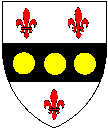 [Thwaites]
[Thwaites]Heraldry developed in mediaeval Europe, particularly England and France in the 12th and 13th centuries. As a result much of the language used in blazons is derived from old French (or Norman French as used in England at the time). Thus we have terms such as semé [scattered or strewn overall with].
The original purpose of distinctive designs was to identify particular individuals on the battlefield – so it was obviously important to have clearly differentiated shields! For this reason the number of colours used is relatively limited, and they are bright and distinct. Similarly the ways of dividing up the shield are mostly simple, as are the “ordinaries”.
As heraldry developed the rules became more detailed. Official bodies were set up to regulate the possession of arms; originally a particular shield was granted to an individual, and it could be passed down through his direct heirs, but only according to a strict set of heraldic inheritance rules. It was not the case that the design belonged to the whole family – so that talk of one’s ‘family crest’ is rather misleading.
Often the arms of two or more families were combined on marriage, and subsequent generations bore them quartered.The complete “achievement” of arms included the shield, supporters, crest, crown or helm (again strict rules applied to what kind of helmet you were entitled to depending on your rank), motto and badge. In this note I intend to deal only with the shield, often wrongly termed the “coat of arms”: this term really applied to the coloured surcoat mediaeval knights wore over their armour, as seen for example in effigies and memorial brasses in English churches.
Blazoning is the term used to mean describing the arms in heraldic language, in a concise and unambiguous way
In blazoning arms there are accepted conventions for the order of describing various elements:
In practice these elements are often combined, e.g. Argent on a fess sable three bezants between three fleur-de-lys gules
 [Thwaites]
[Thwaites]
If you are interested in decoding blazons have a look at the shields on the Heraldry of Gilling Castle pages, where the description and picture are together. I have also drafted a step-by-step guide to blazoning the Thwaites arms.
Back to the Glossary Contents.
© Gill Smith 1997